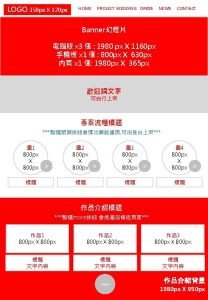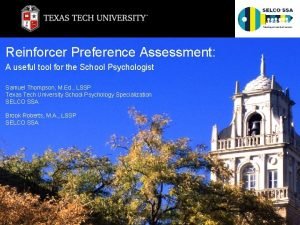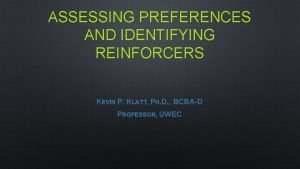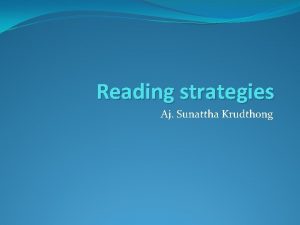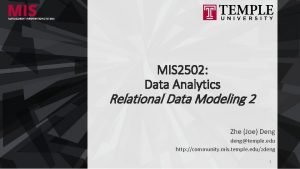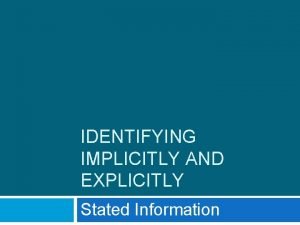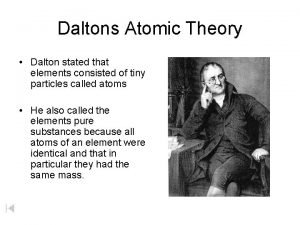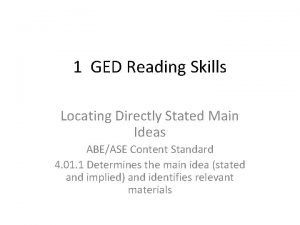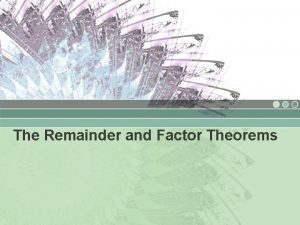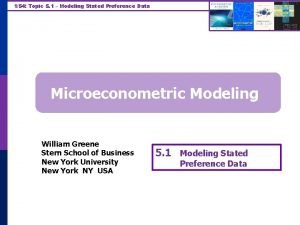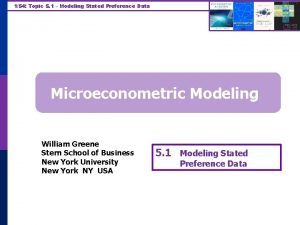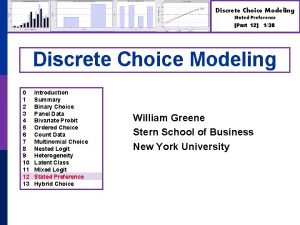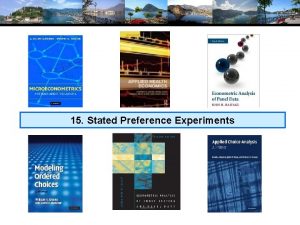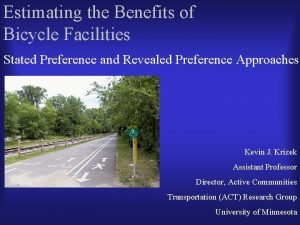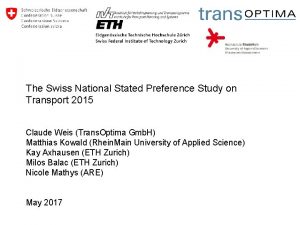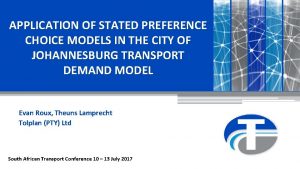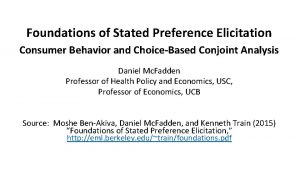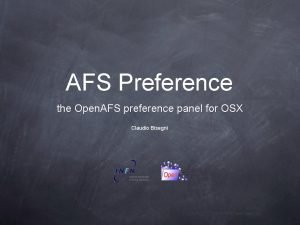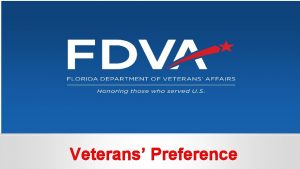120 Topic 5 1 Modeling Stated Preference Data




















- Slides: 20

1/20: Topic 5. 1 – Modeling Stated Preference Data Microeconometric Modeling William Greene Stern School of Business New York University New York NY USA 5. 1 Modeling Stated Preference Data

2/20: Topic 5. 1 – Modeling Stated Preference Data Concepts • • Revealed Preference Stated Preference Attribute Nonattendance Random Utility Attribute Space Experimental Design Choice Experiment Environmental Attitude Models • • • Multinomial Logit Model Latent Class MNL Nested Logit Mixed Logit Error Components Logit

3/20: Topic 5. 1 – Modeling Stated Preference Data Revealed Preference Data p p Advantage: Actual observations on actual behavior n Market (ex-post, e. g. , supermarket scanner data) n Individual observations Disadvantage: Limited range of choice sets and attributes – does not allow analysis of switching behavior.

4/20: Topic 5. 1 – Modeling Stated Preference Data Purely hypothetical – does the subject take it seriously? p No necessary anchor to real market situations p Vast heterogeneity across individuals p E. g. , contingent valuation

5/20: Topic 5. 1 – Modeling Stated Preference Data Strategy Repeated choice situations to explore the attribute space p Typically combined RP/SP constructions p n n p Mixed data Expanded choice sets Accommodating “panel data” n n n Multinomial Probit [marginal, impractical] Latent Class Mixed Logit

6/20: Topic 5. 1 – Modeling Stated Preference Data Application: Shoe Brand Choice p Simulated Data: Stated Choice, n n p 400 respondents, 8 choice situations, 3, 200 observations 3 choice/attributes + NONE n n n Fashion = High / Low Quality = High / Low Price = 25/50/75, 100 coded 1, 2, 3, 4 Heterogeneity: Sex (Male=1), Age (<25, 25 -39, 40+) p Underlying data generated by a 3 class latent class p process (100, 200, 100 in classes)

7/20: Topic 5. 1 – Modeling Stated Preference Data Stated Choice Experiment: Unlabeled Alternatives, One Observation t=1 t=2 t=3 t=4 t=5 t=6 t=7 t=8

8/20: Topic 5. 1 – Modeling Stated Preference Data Application: Pregnancy Care Guidelines

9/20: Topic 5. 1 – Modeling Stated Preference Data Application: Travel Mode Survey sample of 2, 688 trips, 2 or 4 choices per situation Sample consists of 672 individuals Choice based sample Revealed/Stated choice experiment: Revealed: Drive, Short. Rail, Bus, Train Hypothetical: Drive, Short. Rail, Bus, Train, Light. Rail, Express. Bus Attributes: Cost –Fuel or fare Transit time Parking cost Access and Egress time

10/20: Topic 5. 1 – Modeling Stated Preference Data Customers’ Choice of Energy Supplier p p p California, Stated Preference Survey 361 customers presented with 8 -12 choice situations each Supplier attributes: n n n Fixed price: cents per k. Wh Length of contract Local utility Well-known company Time-of-day rates (11¢ in day, 5¢ at night) Seasonal rates (10¢ in summer, 8¢ in winter, 6¢ in spring/fall)

11/20: Topic 5. 1 – Modeling Stated Preference Data Combining RP and SP Data Sets - 1 Enrich the attribute set by replicating choices p E. g. : p n n p RP: Bus, Car, Train (actual) SP: Bus(1), Car(1), Train(1) Bus(2), Car(2), Train(2), … How to combine?

12/20: Topic 5. 1 – Modeling Stated Preference Data Each person makes four choices from a choice set that includes either two or four alternatives. The first choice is the RP between two of the RP alternatives The second-fourth are the SP among four of the six SP alternatives. There are ten alternatives in total.

13/20: Topic 5. 1 – Modeling Stated Preference Data Willingness to Pay for Green Energy

14/20: Topic 5. 1 – Modeling Stated Preference Data

15/20: Topic 5. 1 – Modeling Stated Preference Data

16/20: Topic 5. 1 – Modeling Stated Preference Data

17/20: Topic 5. 1 – Modeling Stated Preference Data

18/20: Topic 5. 1 – Modeling Stated Preference Data

19/20: Topic 5. 1 – Modeling Stated Preference Data

20/20: Topic 5. 1 – Modeling Stated Preference Data Stated Choice Experiment: Travel Mode by Sydney Commuters
 Stated main idea
Stated main idea Helen c erickson
Helen c erickson Relational modeling vs dimensional modeling
Relational modeling vs dimensional modeling Px home
Px home 140+120+120
140+120+120 Bert topic modeling
Bert topic modeling Best practices for data warehousing
Best practices for data warehousing Raisd aba
Raisd aba Paired stimulus preference assessment data sheet
Paired stimulus preference assessment data sheet Concluding sentence
Concluding sentence Broad topic and specific topic examples
Broad topic and specific topic examples Opera reading comprehension
Opera reading comprehension In a minimum cardinality, minimums are generally stated as
In a minimum cardinality, minimums are generally stated as Explicitly stated
Explicitly stated What type of
What type of The r.a. no. 10912 was enacted on
The r.a. no. 10912 was enacted on Stated main idea and implied main idea
Stated main idea and implied main idea Stated main idea examples
Stated main idea examples James chadwick
James chadwick Directly stated examples
Directly stated examples Polynomial remainder theorem
Polynomial remainder theorem



